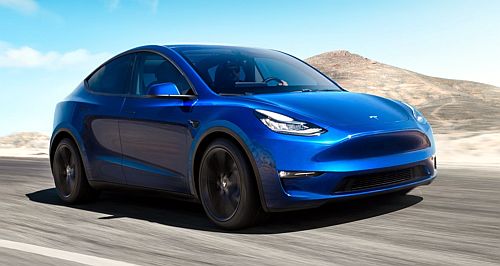News - Market Insight - Market Insight 2023Market Insight: Tesla Model Y climbs chartTesla Model Y shaping up to be Europe’s best-seller in 2023 – and top 5 in Australia5 Dec 2023 By PHILIP LORD TESLA will end 2023 on a sales high with its Model Y medium SUV poised to place in the top five most popular vehicles in Australia based on its performance for the first 11 months of 2023.
Almost lineball with the fifth-placed Toyota RAV4 on just over 27,400 sold year-to-date, the Model Y is also similarly popular to the far less expensive MG ZS that is currently fourth with 27,746 delivered.
The Toyota HiLux, Ford Ranger and Isuzu D-Max round out Australia’s top three sellers.
Of the 80,446 battery electric vehicles (BEV) sold in Australia to date, 43,924 – or 54.6 per cent – were Teslas, while the brand’s overall share of the Australian market stands at 3.9 per cent to place eighth behind MG with 4.9 per cent and just ahead of Subaru with 3.8 per cent.
But the brand’s performance in Europe is even more impressive. Barring any unforeseen changes, the Tesla Model Y will be Europe's number-one selling vehicle for 2023, making it both the first BEV to do so.
The Model Y will also be the physically biggest and most expensive car to take the European top spot as well as being the continent’s first sales leader to come from a non-European brand in decades.
It paints a bright picture for the all-electric US brand in Europe, where targeted legislation helps Tesla sell cars.
But it is a business environment that also helps the many established European ‘home brands’ that for some time have offered EVs on the market but are yet to come close to Tesla sales numbers – such as the pioneering Renault Zoe and many others – plus more to come to meet the upcoming legislation banning internal combustion engine (ICE) vehicles.
According to Automotive News Europe, the Model Y finished the first 10 months of the year with a 15,035 sales lead over the Dacia Sandero (212,517 units to 197,482).
While the five-digit sales advantage over the Sandero is relatively narrow, and much less than the 26,276 sales lead the Tesla enjoyed over the Dacia to the end of September, it would require a big boost in Sandero numbers and a large drop in Model Y sales for the positions to reverse by year’s end.
Model Y monthly sales in Europe have been anything but consistent – for example, it finished in 20th place in October. Yet it has also been Europe's top-seller six times; the Sandero was first in January, April and October, while the Volkswagen T-Roc was the top-seller in July.
The Model Y has accounted for 73 per cent of Tesla's 291,404 total sales in Europe over 10 months, easily overtaking the 232,066 vehicles it reportedly sold in Europe during the whole of 2022, in turn, a 36.1 per cent increase from 2021.
Tesla’s success, like any other brand selling BEVs in Europe, is tethered to government incentives, some of them quite significant.
Such incentives in Europe are led by Norway and The Netherlands, where Tesla established itself early and has continued to cement itself as a sales leader in these countries. Norway, for example, gives BEV owners a 25 per cent VAT exemption and BEV owners are also exempt from paying road tax, tolls or public parking fees.
Tesla’s Australian historical sales are not publicly available, as the brand did not submit its sales data to the VFACTS sales tally until March last year.
Reported estimates have indicated very low Tesla sales here (less than 1000 per year) until 2018, when the brand began its solid sales climb.
Even with myriad new battery electric models from budget Chinese SUVs to high-end European prestige alternatives, Tesla owns the majority of the battery electric segment in Australia with just two models, a medium sedan and a medium SUV – neither of which could be described as cheap.
The least expensive Tesla is a Model 3 RWD, starting at $61,900 (plus on-road costs).  |
Click to shareMarket Insight articlesResearch Market Insight Motor industry news |














Facebook Twitter Instagram